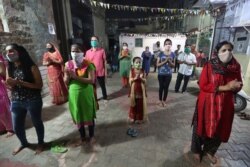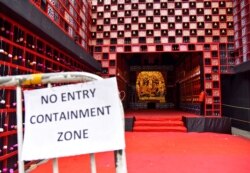India heads into its monthlong Hindu festival season with some good news -- a government-appointed committee of experts says that the COVID-19 pandemic is past its peak and will have run its course by February as daily infections tumble by more than one-third in the world’s second-worst-hit country.
Health experts warn, though, that much of the gain could unravel in a country where large community gatherings and socializing are the hallmarks of festive celebrations, where consumers indulge in a spending spree at this time of the year, and where messages about social distancing and masks are being ignored by many.
In a Tuesday address to the nation, Prime Minister Narendra Modi pointed to Western countries as he appealed to people not to lower their guard during the festive season.
"Recently, we saw many photos and videos where it is clearly seen that people have stopped taking precautions and are not careful anymore. This isn't right,” Modi told the country of 1.3 billion that has counted 7.7 million cases so far.
“Keep in mind, be it America or countries in Europe, cases declined but suddenly increased again, that too alarmingly,” he said.
While Modi’s message is usually heeded carefully in the country, there are fears that people weary of months of restrictions might find it hard to resist socializing during the festivals.
Experts point to the southern state of Kerala to underline how quickly the rampaging virus can defeat successful containment strategies.
Five months ago, the United Nations praised the Indian state for its aggressive tracking and surveillance that kept COVID-19 numbers low and helped prevent the devastation that it was causing in other parts of the country.
However, in the wake of celebrations for the popular 10-day harvest festival Onam, when people mingled and shops opened for longer hours, Kerala quickly went from model state to joining the ranks of India’s hardest-hit regions as it witnessed a massive spike in cases in September.
In recent weeks, India’s daily cases have declined from a peak of 93,000 in September to about 55,000 this week. The government committee’s forecast that India will have “minimal” cases by February is based on projections that many more Indians are likely to have already been infected than reflected in recorded cases.
“Our mathematical model estimates that 30% people in India have been exposed to the virus and by February more than half the population will have antibodies,” according to Manindra Agarwal, a professor in the Department of Computer Science and Engineering at the Indian Institute of Technology, Kanpur, a panel member.
“That is why we estimate that the virus could slow down significantly early next year. But fingers have to be crossed for the festive season – without adhering to protective measures such as masks, we may have a second wave,” he said.
Independent experts agree.
“We are most certainly past the peak. But with numbers still high, there is still significant risk for people and there could be a reversal post-festival,” warns prominent virologist T. Jacob John. “That can be avoided if there is no jostling in crowds during celebrations.”
However, in a country where religious celebrations are important to many people, most states have lifted restrictions on religious gatherings.
In West Bengal state, for example where festivities got underway Thursday, the government has allowed thousands of traditional community celebrations during which people gather for five days to worship idols.
“We will put coronavirus in lockdown and hold Durga Puja [worship of goddess Durga],” West Bengal Chief Minister Mamata Banerjee said last month as she gave the go-ahead for the festivities. However, the High Court, the state’s top judicial body has mandated restrictions on the numbers who can gather at the congregations.
Some are being more cautious -- the worst-affected state of Maharashtra has not allowed temples to reopen, despite demands by political parties, including the ruling Bharatiya Janata Party.
Authorities everywhere are hoping however, the festival season will help kickstart a battered economy – this is also the time when consumer spending peaks on everything from gifts for children to cars for families.
“Sales have plunged by 75% in recent months,” said Kailash Rohra, owner of a toy and sports shop in Gururgram, a business hub near Delhi.
“Gradually people have started coming to markets, but I am still not seeing the usual crowds. I hope that changes,” he said.
The course of the pandemic in India will hinge on the coming weeks, experts say.
“No religion or God says that you have to celebrate in an ostentatious way, that you have to visit pandals and temples and mosques to pray,” Health Minister Harsh Vardhan said earlier this month.
It remains to be seen if that message will be heeded in a country where crowds are the norm at festivals.











